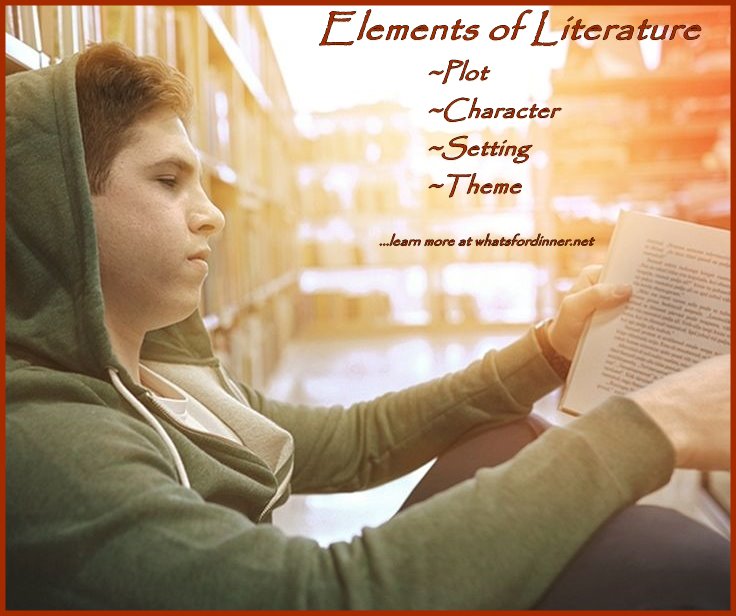
What's For Dinner?
Make dinner time, family time!
Article – Elements of Literature

What's For Dinner?
Make dinner time, family time!
Article – Elements of Literature


– Ajanta Bhattacharyya
Literature is a reflection of the society.
Share It!

Elements of Literature
Subscribe to our free weekly newsletter
Setting: It refers to geographical location of the story, time period, daily lifestyle of the characters and climate of the story. In a novel, the setting plays an important role. In short stories, sometimes it plays an important role, while for others it is not. Settings of literary forms have been changing according to theme of the literary piece, for example, Shakespeare’s tragedies and comedies have the setting of palaces, castles whereas modern and post-modern dramas have setting of houses of common people. There were supernatural elements in earlier literature and nowadays absurdity rules the literature. Setting can take place in a house, school, castle, forest, hospital or anywhere that the writers want to extend their scenes.
Theme: Theme is another prime element of literature, which contains the central idea of all literary forms such as a novel, drama and short story. It reflects innocence, experience, life, death, reality, fate, madness, sanity, love, society, individual, etc. Thus, it reflects the society as a whole, for example, the theme of Hardy’s novel "The Mayor of Casterbridge" reflects the role of fate in our life. Likewise, in a drama, theme represents the brief idea of the drama.
Structure: Structure is another important element of a drama, novel or short story. In dramas, there are plots and subplots. These also are divided into acts and scenes. Here the contrasting subplots give the main plot an additional perspective. Likewise, novels have different chapters and scenes.
Point of view: Point of view is another element of the narrative, through which a writer tells the story. Authors use first-person point of view or third-person point of view. First-person point of view indicates that the main character is telling the story, whereas the third-person point of view directs that the narrator is telling the story. A novel can be written in the first-person narrative, third-person narrative, omniscient point of view, limited omniscient point of view, stream of consciousness and objective point of view. These points of view play an important role in the distinct structure of the story or a play.
Conflict: Be it a short story, drama or novel, conflict is the essential element of all these literary forms. A plot becomes interesting and intriguing when it has its share of inbuilt conflict and twists. Conflict can be internal conflict or external. It can take place between two men, between the character and his psychology, between the character and circumstances or between character and society.
Use of language or diction: Diction is another essential element of drama. A playwright exhibits the thoughts of characters through dialogue. "Dialogue" has come from the Greek word "dialogosa" which means "conversation". Shakespeare used this to portray the thoughts, emotions and feelings of the character. This also provides clues to their background and personalities. Diction also helps in advancing the plot. Greek philosophers like Aristotle used dialogue as the best way to instruct their students.
Foreshadowing: Foreshadowing is another important element of literature that is applied as hints or clues to suggest what will happen later in the story. It creates suspense and encourages the reader to go on and find out more about the event that is being foreshadowed. Foreshadowing is used to make a narrative more authentic.
Poetry is literature in a metrical form. However, free-verse became the popular style towards the modern and post modern age. Like fiction, it may not have plots, setting, etc, yet it has a structured method of writing. There are various kinds of poetry such as ballad, sonnet, etc. All these forms have some elements such as style, theme, rhyme, rhythm, metaphor, etc. that are described below:
Style: Style refers to the way the poem is written. Poems are written in various styles, such as free verse, ballad, sonnet, etc., which have different meters and number of stanzas.
Symbol: Symbol represents the idea and thought of the poem. It can be an object, person, situation or action. For example, a national flag is the symbol of that nation.
Theme: Like other forms of literature, poetry has a theme of its own. Theme contains the message, point of view and idea of the poem.
Imagery: Imagery is another important element that a poet often uses in poems that appeal to our senses. In the age of modernism, T.S. Eliot used images of urban life in his poems. Wordsworth used nature as poetic images in his poems.
Rhyme and rhythm: Rhyme is an element that is often used in poetry. It’s a recurrence of an accented sound or sounds in a piece of literature. Poets and lyricists use this device in various ways to rhyme within a verse. There is internal rhyme, cross rhyme, random rhyme and mixed rhyme. It gives the poem flow and rhythm. It contains the syllables in a poem. Every poem has a rhythm in it. It’s about how the words resonate with each other, how the words flow when they are linked with one another in a poem.
Meter: This is an important rhythmic structure of poetry. It is described as sequence of feet, each foot being a specific series of syllable types - such as stressed/unstressed and makes the poetry more melodious.
Alliteration: Alliteration is another element used in poetry for the sound effect. It indicates two or more words with same repetition of initial letter, for example, "dressy daffodils". Here the sound of the letter ‘d’ is repeated.
Simile: A simile is a figure of speech used for comparison in the poetry with the words ‘like’ or ‘as’, for example, "as black as coal".
Metaphor: Metaphor is used in poetry to make an implicit comparison. Unlike simile, here the comparison is implied, for example, ‘Her laughter, a babbling brook’.
Onomatopoeia: This is one important element of poetry, which refers to words that sound like their meaning, for example, buzz, moo and paw.
Element of literature includes all the elements that are essential to create a piece of literature. These elements help a writer to create splendid poetry, superb drama and soul-touching novel. These elements are used to form the structure of a literary piece.